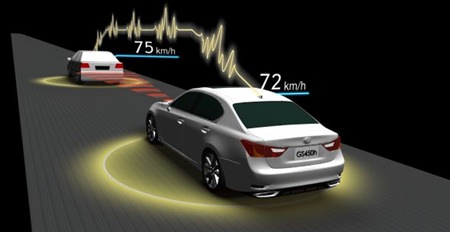As the motorcar heads towards autonomous operation, the manufacturers also have to integrate safety systems for this next step. Many of these systems are already in existence, but currently too expensive for general fitment.
The latest Toyota advanced systems were revealed at the Toyota Advanced Safety Seminar. These include:
Automated Highway Driving Assist to keep a car within its highway lane, at a safe distance from surrounding traffic.
New, improved laser obstacle detection system.
New 3D head-up display.
Laser detection systems that can track objects on the road, day and night; 3D information displays that transform the way traffic information is delivered to drivers; and an advanced driving support system that will be on the road within the next few years; these were the highlights of the innovation program revealed at the fourth Toyota Annual Advanced Safety Seminar in Ann Arbor, Michigan.
 AHDA in action.
AHDA in action.
The seminar provided an early insight into the company’s latest safety research and development work and the progress it is making in securing safer mobility for all in the future.
“Toyota’s vision is of a world without traffic fatalities, and these advanced connected and automated vehicle technologies have the potential to revolutionize automotive safety,” said Seigo Kuzumaki, Toyota’s Chief Safety Technology Officer. Items discussed at the seminar included:
Automated Highway Driving Assist (AHDA): First revealed last year in Japan, Toyota’s AHDA system is designed work with the driver to achieve safe car control. The latest version of the system, unveiled at the seminar and to be shown at the ITS World Congress, has been programmed according to real-world traffic conditions in the USA and can operate at speeds up to 90 kph.
AHDA integrates three core technologies: Dynamic Radar Cruise Control, Lane Trace Control and Predictive and Interactive Human-Machine Interface (HMI). These support the driver by keeping the vehicle to its lane and a safe distance from others on the road, all while travelling at cruising speeds. The Predictive and Interactive HMI promotes driver engagement, warning when the system is going to disengage and monitoring the driver’s level of attention on the road ahead.
Dynamic Radar Cruise Control (DRCC): This system allows drivers to maintain speed and make more comfortable progress while reducing accident risk by keeping a safe distance from the vehicle ahead. It uses a 77 GHz millimeter-wave radar to detect and monitor vehicles in front of the Toyota and maintain specific speeds and distances.
Lane Trace Control (LTC): Lane Trace Control helps the driver keep the car safely within its lane, using signals relayed by a front-mounted camera and a millimeter-wave radar. The sensors detect lane markings on the road surface and vehicle ahead. The system calculates the right driving path, automatically adjusting the vehicle’s steering angle so the Toyota keeps within its lane, within an appropriate margin from surrounding vehicles.
Predictive and Interactive HMI: While the improved automation provided by the Dynamic Radar Cruise Control and Lane Trace Control contribute to making driving safer and more comfortable, it remains essential to keep the driver – the most important element in the driving process – focused. For this reason, AHDA includes a predictive and interactive HMI to help there is a smooth, safe transition as the car moves from automated and manual driving.
The system gives the driver advance warning when only limited automated system support can be expected. It makes its predictions on the basis of the lay-out/geometry of the road ahead and historical sensor performance. These predictions are intelligently generated, so they apply specifically to the traffic lane in which the AHDA vehicle is travelling.
Monitoring technologies are used to check the driver’s level of attention on the road ahead. An infra-red camera monitors the driver’s face and a touch sensor locates where the driver’s hands are on the steering wheel. The system warns the driver if it detects their hands are off the wheel, or their eyes are not on the road ahead for a long period.
Spad Lidar – single photon avalanche diode/light detection and ranging: Toyota demonstrated its SPAD LIDAR environment mapping and recognition system for the first time at its safety seminar, a technology that marks important progress towards making automated driving a reality. As well as performance improvements, the system is smaller than the previous bulky units which had to be mounted on the roof, and can be installed inside the car.
The high-resolution LIDAR (laser radar) combines the functions of a millimeter-wave radar and stereo cameras. It can detect the shape and position of obstacles ahead and its active sensors mean it can operate in daylight and at night.
3D head-up display: Toyota’s innovative 3D head-up display reflects the company’s philosophy that advanced safety technology should work as a teammate with the driver, and breaks new ground in interface design. The system projects critical information onto the windscreen, such as vehicle status, traffic conditions and road signs, rendering it in 3D with no need for the driver to wear special glasses or use other accessories.
It uses completely new 3D viewing technology and is designed to display information at specific points on the road.




